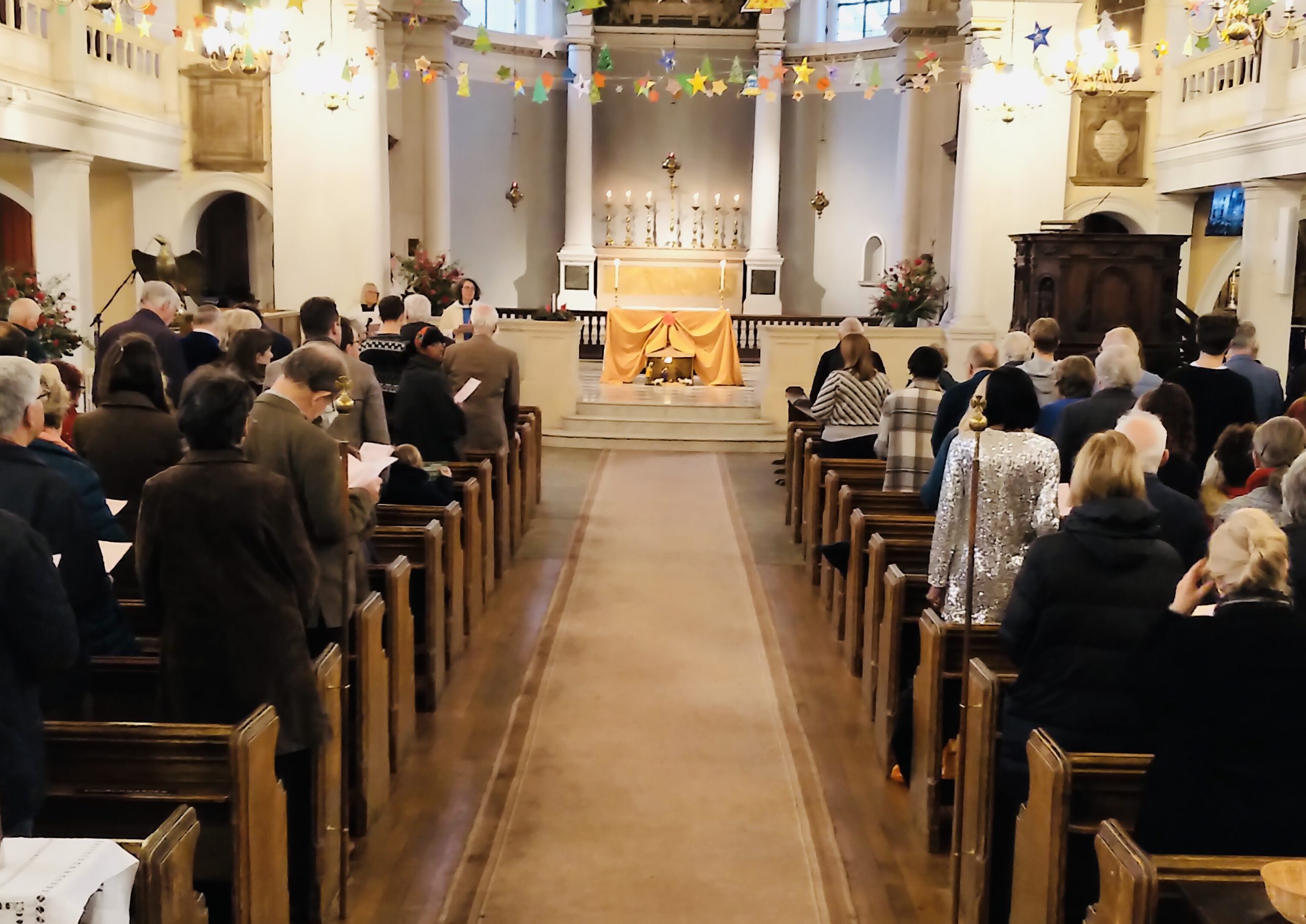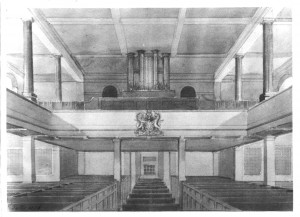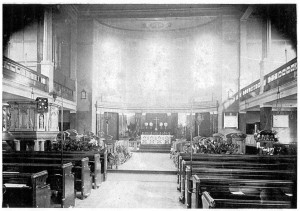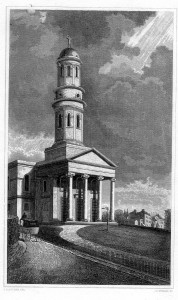 The church of St Anne Wandsworth
The church of St Anne Wandsworth
(Listed Grade II *)
A Commissioners’ Waterloo Church
In 1818 an Act of Parliament was passed to set up a Commission for “promoting the building of churches and chapels in populous parishes”, the so-called Commissioners churches. The first of these churches were also termed Waterloo churches because they were looked upon as national monuments built in thanksgiving for the victory over Napoleon at Waterloo. St Anne’s was the fifth Waterloo church, initially a Chapel of Ease for All Saints, Wandsworth parish, until becoming a parish in its own right in 1850.
The original building.
Designed by Robert Smirke – architect of the British Museum – it was completed on 29th July 1822. Developed on high ground above the Wandle valley on the (then) edge of the suburbs, it became known variously as ‘St Anne’s in the Fields’ and as the ‘Pepper-pot Church’ because of the shape of its tower. (It was St Ann, from the hill on which it stands, not St Anne until at least 1847!) The main body of the church is built of yellow gault bricks with stone dressings and sits behind a giant stone Ionic portico above which a round tower rises from a square base (considered by Pevsner to be “exactly twice as high as it should be”).
The church as Smirke originally conceived it differs from today’s church: the east end was much smaller with three lancet windows, the nave was fitted out with high Georgian box-pews, and the gallery extended at the west end to the next pair of pillars, where it housed the organ. (The north-west corner of the nave under the gallery has since been closed off to provide a servers and clergy vestry.)
Although the building was completed structurally on 29th July 1822, it remained unconsecrated until 1st May 1824 because of a dispute between the Bishop of Winchester (the then diocese) and the parish over whether the churchyard should be enclosed by a wall or a fence. The churchyard remains unconsecrated to this day and thus never became a graveyard.
The new chancel and chapels
In 1890 the vicar, Edward Granger Hall, began a whole series of alterations (completed under Norman Campbell) – the removal of the box-pews, the narrowing of the gallery, and the building of the apsidal chancel with its associated side chapels. Edward Mountford – architect of the Old Bailey – designed the chancel which was completed in 1896. Pevsner describes the chancel as a fairly conservative neo Wren but John Betjeman calls it swaggering baroque. Most agree however that the late Victorian chancel sits remarkably well with the Regency nave. A bas-relief of The Last Supper over the high altar is attributed to Doulton & Co, of Lambeth.
Mountford was a churchwarden and the Mountford Memorial chapel on the south side of the chancel (now re-designated the Lady Chapel) is a memorial to his wife, Jessie. The decoration (particularly the hanging lamps) is heavily influenced by the Arts and Crafts movement. The painting behind the altar is an amalgam of several famous works of art.
The north east chapel was originally a vestry but was converted (1925) to the Blessed Sacrament chapel and is now dedicated to St Faith to recognise the rejoining of St Faith’s to St Anne’s parish (split from it in 1884). Behind the altar hangs a 16th C Italian painting of the adoration of Christ by the wise men.
The interior in about 1892 with the new pews, pulpit and choir stalls. The gallery front has been cut back – and the organ moved – but the chancel not yet rebuilt.
War and other damage
A Flying Bomb in 1944 blew out almost all the windows and rendered the tower and nave unsafe. St Anne’s had very little stained glass and all that survived the 1939-45 war is in the Lady Chapel. The church was restored in 1947. However in 1950, a fire again devastated the church, completely destroying the roof. This was reconstructed using a steel framework instead of wooden purlins. A wooden internal porch on the south door was erected. The church was finally re-dedicated in Dec.1951.
More recent restoration and changes
By the late 1970’s the fabric of the church was in a very poor state. The exterior was covered in grime, and the stonework crumbling and the interior paintwork had become very dirty. The building looked redundant. Repairs were carried out to the most seriously eroded stonework, to the copper and lead roofs, and to eradicate long-horn beetle and dry rot. It was also found possible to overhaul the electrics, replacing the lightning conductor, long since stolen for its lead. This work was completed by 1983. Internal redecoration in traditional Georgian colours was made possible by parish donations and a legacy from Clifford Hobbs who had been Church Organist.
In 1985, a very large legacy from a parishioner, Elsie Nightingale, provided money for many general repairs, including at this time a complete overhaul of the heating system. A Repairs Fund was established.
In 1991 a second extensive restoration exercise was embarked upon. With a substantial grant from English Heritage, it was possible to clean and fully restore the exterior. The church was rewired. The organ (Forster and Andrew, 1890s) was rebuilt in 1996 by Rushworth and Dreaper of Liverpool. The organ console that had been moved from above the Lady Chapel to the chancel, was now moved again to the nave. At the same time the eagle lectern was moved from the south to the north aisle in front of the console.
After the rebuilding of the organ, the chancel was reordered. The fixed choir stalls were removed, and the wooden floor where they stood has been replaced by marble, matching the existing pattern. At the request of English Heritage, a thin brass strip marks where the stalls stood. A free-standing altar is now used.
The lighting and electrical system was totally redesigned and replaced in 2005.
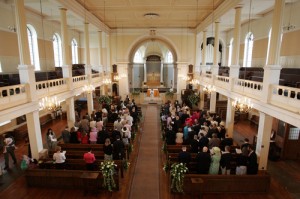 The interior of the church today
The interior of the church today
Memorials
There are many memorials around the church. The pulpit (1893) is a memorial to the Dubuisson brother and sister, James and Elizabeth. The choir stalls (now in the nave) are also Dubuisson memorials. The family held the patronage of St Anne’s until 1902. They gave generously to many local causes, including large sums to the fighting fund to save Wandsworth Common from development.
The brass lectern (1894) is a memorial to Edward Grainger Hall, Vicar from 1890 -1894. Its stand is made from fossil–rich Frosterley marble, mined in Weardale, Yorks, and valued for its beauty when polished.
At the back of the nave, at either side of the entrance is the 1914-18 war memorial (erected 1920). On it are the names of the 313 men of the parish who died in the 1914-18 war, including Frank Harvey VC. A small brass memorial in the chancel gives the names of those who were members of the Church.
St Anne’s Bicentenary Anniversary Open House Talks
Recorded by John Crossland with thanks to the Wandsworth Society
